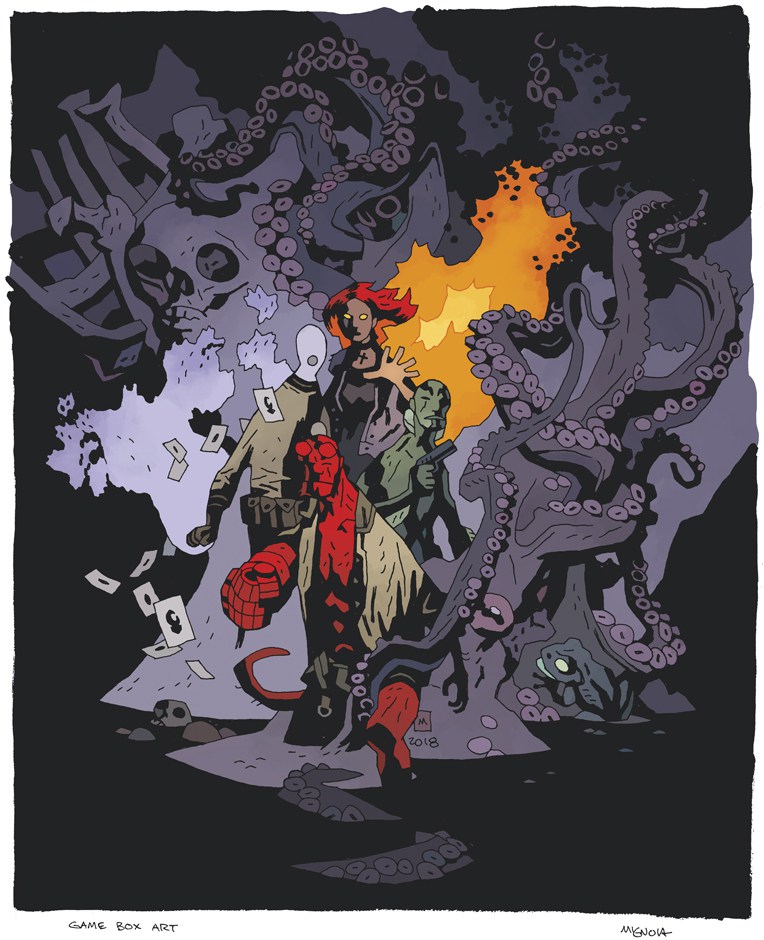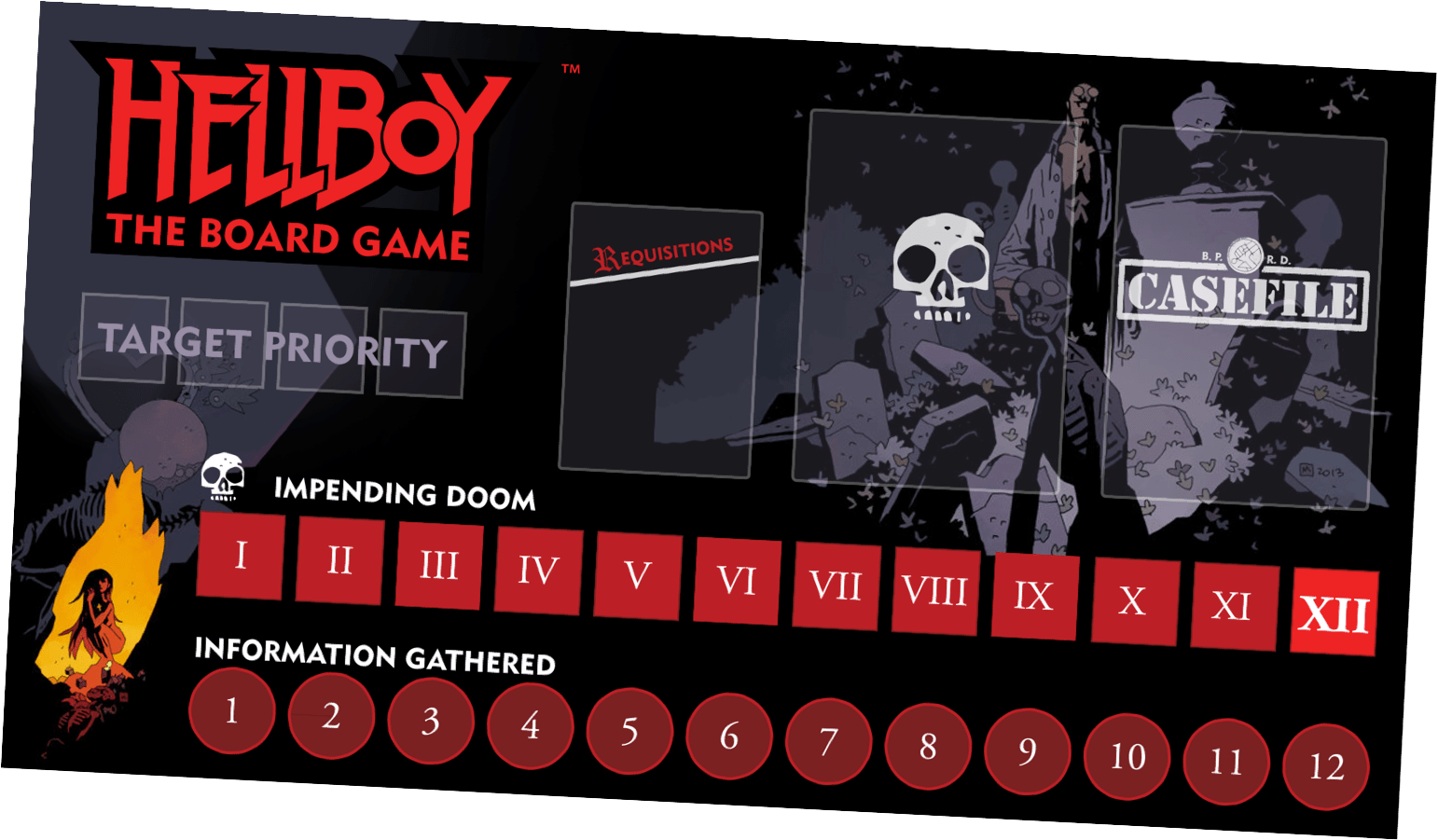
Hellboy: Developing the Game (Part Two)

In yesterday’s blog we talked about the early stages of development for Hellboy: The Board Game. You can check it out here. For today’s entry we’re looking at how the game progressed once James M. Hewitt (founder of Needy Cat Games) became involved with the project.
James is a very lovely chap and he’s worked with us before on the awesome DreadBall and was our much-loved community manager for about a year. He was also a designer at Games Workshop and worked on big titles like Warhammer Quest: Silver Tower, Blood Bowl 2016 and Necromunda 2017, among others. He’s kind of a big deal (and he’ll let you know this within five seconds of meeting him… if he even lets you look him in the face). From Mantic’s point of view it was extremely exciting to have James on board and he once let us make eye contact in a meeting.
Immediately James began tinkering with the basic mechanics we’d established, i.e. a co-operative game for up to four players in which the BPRD explores a gothic location and hunts down a suitably terrifying beast! Yeah, so not a lot to work on…
However, something that James immediately realised from reading the comics is that there’s a huge amount of investigating involved in the original stories. Often Hellboy and the crew won’t know exactly what they’re facing. Instead they must hunt for clues at the scene and, invariably, fight some wicked minions along the way, before facing off against a towering monster (like Sadu-Hem below).

With this in mind, James began by splitting the gameplay into two key elements: investigating and, somewhat inevitably, combat. For the investigation element you’ll have to search your surroundings for clues about the threat you’re hunting down. If you fail to find a piece of the puzzle, then the final confrontation will be a whole lot tougher.
Combat is also a key part of the comics and James wanted to ensure this was as cinematic and fun as possible. As a result you’ve got Hellboy punching monsters around, Liz setting fire to things, Abe taking aim with his gun and Johann possessing his enemies. The combat (and investigating for that matter) both use a really simple but rewarding custom dice system that we’ll cover in a later blog.

With the two elements of gameplay defined, this led to the creation of the Impending Doom Track and the Information Gathered Track. The former tracks how much danger the agents are in and how close they are to the final fight. While the latter shows the amount of evidence they’ve gathered. This could be a piece of equipment or vital information that will expose an important weakness ahead of that end battle. A key part of the game is successfully balancing these two elements and there’s often a frantic race to grab that crucial info before the Impending Doom track reaches its dramatic conclusion. Stay tuned to a future blog for more details about these.

Work in progress. Artwork and final design subject to change/approval.
Another genius element introduced by James was the creation of the Case File deck. We always had the idea that it would be great if missions were contained in a top secret envelope so you never knew what was coming. However, James took that one step further with the Case Files. Before each mission you’ll need to crack open a small, top secret envelope to unveil a deck of cards.
These cards act as the scenario generator for the mission and explain things like how to set up the board and trigger special events. Thanks to the secretive nature of these cards, the first time you play a mission, you’ll have absolutely no idea what’s in store. Even the final boss might be a mystery. Even better, after you’ve played a mission, you can mix the Case Files up to create a bespoke experience! It also led to the creation of the thrilling BPRD Archives expansion, which is something we’ll be exploring in more depth soon.
Finally James’ other key idea was the exploration mechanic. The Case File reveals the initial set-up but after that you’re on your own. Each time you enter a new room you’ll flip over an Encounter Card. Each room is split into four areas and the Encounter Card tells you what’s inside, e.g. some monsters, a clue or a piece of furniture to search. A little like the Deck of Doom cards, these are placed randomly so each game has the potential to play differently, even if you’ve completed the mission before.
To surmise all the above, James has turned what we always thought would be a good game into an absolutely GREAT game. The playtesting we’ve been having here at HQ has been fantastic fun and you’ll soon be able to see the game in action with a full gameplay video.

Remember, Hellboy: The Board Game will be hitting Kickstarter on April 25th. We’ve got a very exciting opening pledge level planned, so make sure you don’t miss out. What’s more, next week will be Hellboy Week across the Mantic Blog and social media. Find out more about the game, see the miniatures and plenty more!
The post Hellboy: Developing the Game (Part Two) appeared first on Mantic Blog.
